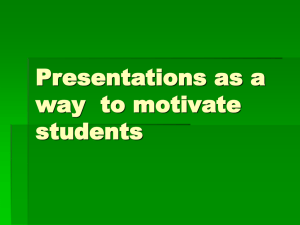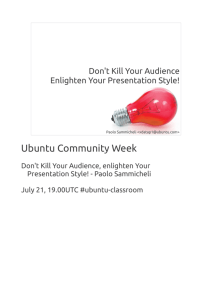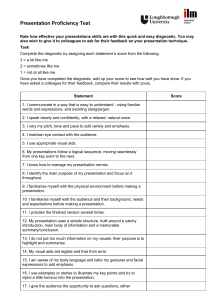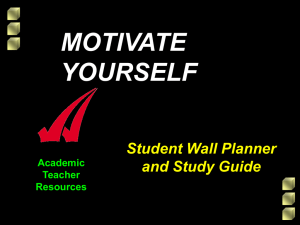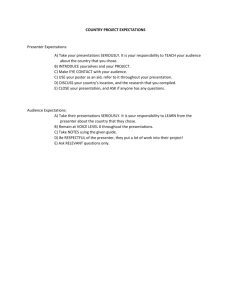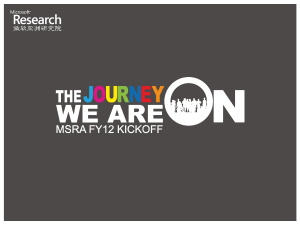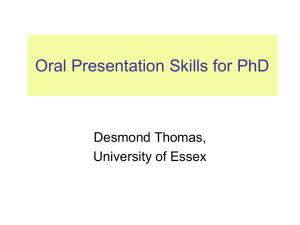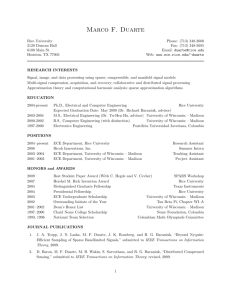Beyond PowerPoint Handout
advertisement
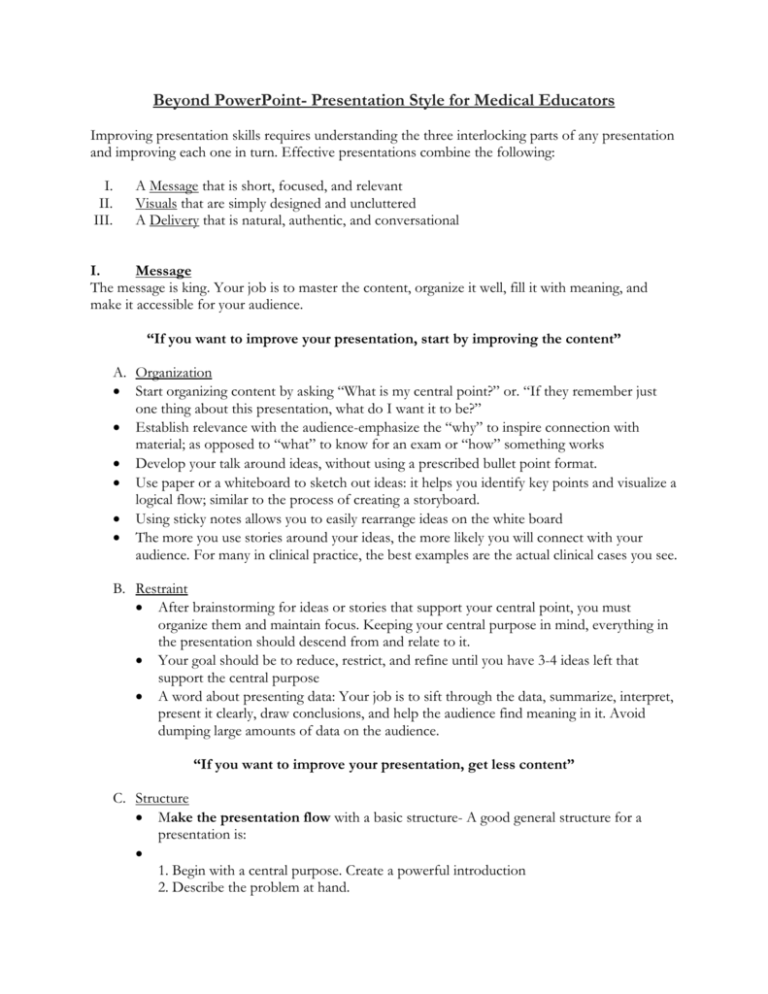
Beyond PowerPoint- Presentation Style for Medical Educators Improving presentation skills requires understanding the three interlocking parts of any presentation and improving each one in turn. Effective presentations combine the following: I. II. III. A Message that is short, focused, and relevant Visuals that are simply designed and uncluttered A Delivery that is natural, authentic, and conversational I. Message The message is king. Your job is to master the content, organize it well, fill it with meaning, and make it accessible for your audience. “If you want to improve your presentation, start by improving the content” A. Organization Start organizing content by asking “What is my central point?” or. “If they remember just one thing about this presentation, what do I want it to be?” Establish relevance with the audience-emphasize the “why” to inspire connection with material; as opposed to “what” to know for an exam or “how” something works Develop your talk around ideas, without using a prescribed bullet point format. Use paper or a whiteboard to sketch out ideas: it helps you identify key points and visualize a logical flow; similar to the process of creating a storyboard. Using sticky notes allows you to easily rearrange ideas on the white board The more you use stories around your ideas, the more likely you will connect with your audience. For many in clinical practice, the best examples are the actual clinical cases you see. B. Restraint After brainstorming for ideas or stories that support your central point, you must organize them and maintain focus. Keeping your central purpose in mind, everything in the presentation should descend from and relate to it. Your goal should be to reduce, restrict, and refine until you have 3-4 ideas left that support the central purpose A word about presenting data: Your job is to sift through the data, summarize, interpret, present it clearly, draw conclusions, and help the audience find meaning in it. Avoid dumping large amounts of data on the audience. “If you want to improve your presentation, get less content” C. Structure Make the presentation flow with a basic structure- A good general structure for a presentation is: 1. Begin with a central purpose. Create a powerful introduction 2. Describe the problem at hand. 3. Describe, with specific examples, how it relates to your audience 4. Provide information about how to improve the problem. (your 3-4 key points) 5. Describe the next steps-a call to action. Cycle back to central purpose. Remember that what you say last will be remembered most, so be sure to re-emphasize your central point at the end. II. Visuals The operative word for your visuals is simplicity-the less clutter on your slides, the more powerful your visual message will become. Slides should be as visual as possible and support your main points quickly, efficiently, and powerfully. The visuals should be a necessary component of the talk, not overpowering the presenter, and not just decoration or reminder notes. Visual are meant to support your narration as a speaker, not make you superfluous. There is no “correct” formula or agreed upon set of rules for slide design, but…if you’d like to improve immediately do these simple things: o Use sans serif fonts; they are generally best for large presentations, and make sure it can be read from the back of the room. o Make slides that reinforce your words, not repeat them. Never turn your back on the audience and read text from the slide word for word. It diminishes your credibility o Avoid bullet points on slides o Avoid clipart images. As much as possible, use high quality stock photography images. o Avoid flashy transitions-the dissolves, spins, words wooshing in or out, or small creatures doing jumping jacks in the corner of the screen. These often do little to support the message and can be distracting. Your time is better spent crafting the message and mastering your delivery. o Nothing in your slide should be superfluous, ever. III. Delivery Tips to appear confident, relaxed, and professional 1. Stand tall-don’t rock, sway, shuffle, or lean 2. Keep your head and eyes up 3. Smile-sincerely 4. Never retreat from the audience 5. Move with purpose, energy, and enthusiasm Tips to avoid verbal fillers 1. Identify them. To improve, you must videotape yourself or solicit honest feedback 2. Recognize patterns (typically at the transition points of a presentation or thought) 3. Anticipate 4. Pause and resist the urge to fill Tips to reduce anxiety 1. Rehearse in 3-5 minute segments. 2. Memorize the first 2 minutes-when you nail it, it will help you settle into a rhythm. 3. Videotape yourself; audiotape 4. Use speaker notes 5. Visualize success 6. Deep breathing 7. Exercise 8. Be Yourself! 9. If nothing else, take comfort in knowing that the audience wants you to succeed! Tips for engaging your audience 1. Tell them up front that participation is expected 2. Ask a question and wait for a response 3. Say “write this down” 4. Use props-maps, flipcharts, dry erase boards, drawings. Set them up throughout the room to create movement and energy 5. Use an outline that requires them to fill in the blank 6. Use them in your stories or examples 7. Use names. Helps refocus the audience 8. Ask their opinion 9. Conduct a survey: Show of hands 10. Group discussions and assignments 11. Share something current and relevant 12. Use short video clips that match your message 13. Reward someone for a correct response Suggested Resources Books The Exceptional Presenter By Tim Koegel http://www.exceptionalpresenter.com/ Presentation Zen Simple Ideas on Presentation Design and Delivery By Garr Reynolds http://www.presentationzen.com/ Presentation Zen Design Simple Design Principles and Techniques to Enhance Your Presentations By Garr Reynolds http://www.presentationzen.com/ The Naked Presenter Delivering Powerful Presentations With or Without Slides By Garr Reynolds http://www.presentationzen.com/ Slide:ology The Art and Science of Creating Great Presentations By Nancy Duarte http://www.duarte.com/books/ Resonate Present Visual Stories That Transform Audiences By Nancy Duarte http://www.duarte.com/books/ Beyond Bullet Points By Cliff Atkinson http://beyondbulletpoints.com/ Anything by Edward Tufte (for the advanced learner) http://www.edwardtufte.com/tufte/ Websites “Four Type Rules For Presentations” http://www.dynamicgraphics.com/dgm/Article/28489/0/page/1/index.html “What are the best fonts for making powerpoint presentation slides?” http://www.labnol.org/software/tutorials/advice-select-best-fonts-for-powerpoint-presentationslides/3355/ “Top 10 Presentations Ever” http://www.knowhr.com/blog/2006/08/21/top-10-best-presentations-ever/ “Effective Presentation Techniques” http://www.buzzle.com/articles/effective-presentation-techniques.html “10 Rules to Instantly Improve Your Presentations” http://blog.hubspot.com/blog/tabid/6307/bid/5975/10-Rules-to-Instantly-Improve-YourPresentations.aspx Note and Point (great creative examples of Powerpoint and Keynote presentations) http://noteandpoint.com/ Nancy Duarte http://www.duarte.com/ Blogs Guy Kawasaki http://blog.guykawasaki.com/#axzz1Py3K7Kcq Garr Reynolds http://www.presentationzen.com/ Seth Godin http://sethgodin.com/sg/default.asp Sample Presentations (Video) The Last Lecture-Randy Pausch (incredibly inspirational) http://www.youtube.com/watch?v=ji5_MqicxSo Dick Hardt-Keynote Identity 2.0 http://identity20.com/media/OSCON2005/ Technology, Design, Entertainment (TED) http://www.ted.com/ Comedian Demetri Martin (low-tech presentation, hilarious) http://comedians.jokes.com/demetri-martin/videos/demetri-martin---findings Images iStockphoto http://www.istockphoto.com/ Corbis images http://www.corbisimages.com/
